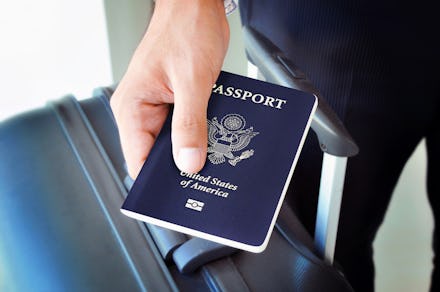Tripped Up: What happens if you lose your passport abroad?

Few things can take an international vacation from great to grim like losing your passport. Not only is it a serious pain if you have to get home anytime soon, but it’s also a security risk—which means it’s important to resolve the issue as quickly as possible. If your U.S. passport gets lost or stolen while traveling abroad, take the following steps to protect your personal information and get a replacement.
Know and plan for the risks
Paige Hanson, chief of identity education at Norton LifeLock explained that while the damage someone can do with only your passport number is limited, the risks are far greater once they have the physical document in-hand.
“The passport number combined with your personally identifiable information (PII) such as your name, address [and] date of birth are the elements fraudsters need to create a fake passport on the black market,” she said. “Having a valid passport number, plus your PII and the thief’s photo equals close to guaranteed access to move throughout a country quietly.” To avoid that happening, put your passport in a locked safe or other secure spot when you’re not using it; and avoid carrying it around while you travel, Hanson added. Before you travel, make a copy and keep it separate from the real deal, but accessible in case of emergency.
File a report with the U.S. Department of State
As soon as you notice your passport is gone, file a report with the State Department online, via snail mail (you’ll need to print and complete the DS-64 form), or over the phone (call 1-877-487-2778). According to the State Department’s website, as soon as your passport is reported lost or stolen, it will become invalid and can’t be used for travel—even by you, if you find it. If you were the victim of the crime or believe the passport was stolen, you can file a police report as well—though, per the State Department, it’s not required and you may want to skip this step if it could hold you up and cause you to miss a flight.
Apply for a replacement
If you’re abroad, visit the nearest U.S. Embassy or Consulate to apply for a new passport. Per the State Department, bring your new photo (info on that below), along with any ID you have (such as a driver’s license), evidence of your citizenship (this is where the copy you made comes in) and your travel itinerary (such as your airline confirmation). If you filed a police report, bring that along, too. You’ll also need the aforementioned DS-64 form and a DS-11 form (an application for a new passport), but those can be completed on-site. If you’re missing any of these documents, just bring what you have: the State Department website says that the “consular staff will do their best to assist you to replace your passport quickly.”
If you need to travel internationally, whether to another country or to return home to the States, in the immediate future; you can apply for an emergency, “limited-validity” passport; once you’re home, you’ll have to turn it in to get a full-blown replacement. Keep in mind, though, according to the State Department, most embassies and consulates won’t issue passports on weekends and holidays when they’re closed (though they always have after-hours officers available to help with life or death emergencies).
Expect to pay usual passport fees ($110 for passport renewal plus $60 for expedited service); if you can’t, give the embassy or consulate staff the name(s) of someone who can help you or ask about your options for financial assistance.
Get a new passport photo
You’ll need a new passport photo to get a replacement. You can take one yourself (there are even various apps to guide you through the process); but keep in mind that whatever method you choose, the State Department maintains strict policies for what qualifies as an acceptable passport photo. Read through them before getting yours to ensure it will be accepted. And if you’re not sure where to get one in a foreign country, contact the nearest U.S. Embassy or Consulate for guidance.
Keep an eye on your finances
As soon as you report your passport lost or stolen, it will be registered as invalid. But if there was a gap between when it went missing and when you file that report, it’s possible your information can be used for identity theft. “Check your credit report to see if a thief has attempted to open a new credit card or another account in your name,” Hanson said. And if anything looks off on your credit report, your bank and credit card accounts, or anything associated, “alert the company as soon as possible to the activity to help protect your accounts.”
Before, during and after travel, stay as organized as possible. Keeping close tabs on your important documents and information will not only help you avoid a lost passport situation to begin with, but it will also help make the process as painless and efficient as possible if something does go awry.